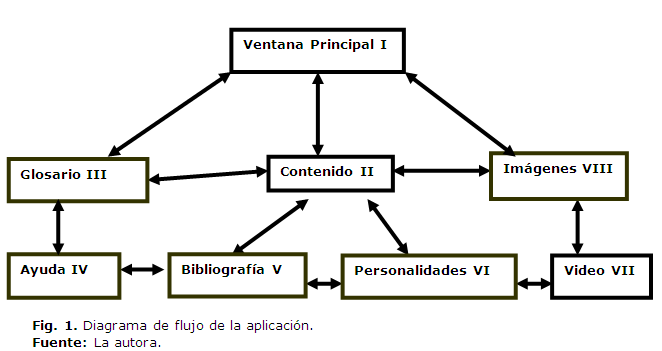Designing of a software for the teaching of the subject Programming and Database Managers in the major Health Technology
Keywords:
Software/standards/classification.Abstract
Introduction: The computer and the educative software, as teaching aids, come to be excellent means for the professor to achieve a better preparation and development of the lessons.
Objective: to design a software about programming and databases managers for improving the training process of students, professors and advisors of the major Health Information Systems.
Material and method: an applied and prospective research (Technologic Development) was carried out in Simon Bolivar Pinar del Río Health Technology Branch, using as main methods: logical-historic, bibliographic review, and modelling, based on the software engineering methodology nowadays applied and counting on the subject's main professor's criterion.
Results: the students' criteria regarding the design, the development of new motivation modes, and multimedia resources selection to insert into this product were obtained, as well as the development of some elements of software engineering applied in the technologic letters for this type of design, in obtaining every single item to be created and their properties, facilitating their placement into the described interface. Conclusions: this software design is of great importance for creating the described software and that will be used in the major's lessons, because it provides motivation and learning means within them, and well as better information management and facilitates the students' and professors' training at any time.
Downloads
References
1. Edel-Navarro R. Entornos virtuales de aprendizaje: la contribución de "lo virtual" en la educación. Revista mexicana de investigación educativa. [Internet] 2010 [Citado 20 de abril de 2012]; 15(44): [Aprox. 8p.]. Disponible en: http://www.scielo.org.mx/scielo.php?script=sci_arttextpid=S1405-66662010000100002lng=estlng=es
2. Jerez Naranjo YV, GarofaloHernandez AA. Aprendizaje basado en tareas aplicado a la enseñanza de las Telecomunicaciones.EAC [Internet] 2012 [Citado 20 de abril de 2012]; 33(3). Disponible en: http://scielo.sld.cu/scielo.php?script=sci_arttextpid=S1815-59282012000300001lng=esnrm=iso
3. Tendencias de la aplicación de las nuevas tecnologías de la Información y la Comunicación en el mejoramiento del proceso de enseñanza. Association of Research Libraries. Definition and Purposes of a Digital Library. [Internet]. 2002 [citado 12 Mayo 2010]; 30(1): [aprox. 3 p]. Disponible en: http://sunsite.berkeley.edu/ARL/definition.html
4. Careaga Butter MY. Fundamentos acerca de un modelo cibernético de Educación. La Habana: Pueblo y Educación; 2002. p.5.
5. Cervantes Montero G, Milán Palmer M. La informática educativa como medio de enseñanza. Cuadernos de Educación y Desarrollo. [Internet] 2011 [Citado 20 de abril de 2012]; 3(28). Disponible en: http://www.eumed.net/rev/ced/28/cmmp.htm
6. Labañino Rizzo C. Guía de evaluación de hiperentornos de aprendizaje. La Habana: Ministerio de Educación; 2009.
7. Cabello R, Morales S, Feeney S. La incorporación de medios informáticos en la enseñanza: políticas y propuestas para la formación docente. Argentina: Universidad Nacional de General Sarmiento y Universidad Nacional de Córdoba; 2009. Disponible en: http://www.razonypalabra.org.mx/anteriores/n52/32CabelloMoralesyFeeney.pdf
8. López Y. Diseño de un Programa Computacional Educativo (Software) para la Enseñanza de Balance General. Formación universitaria. [Internet] 2011 [Citado 20 de abril de 2012]; 4(3): [Aprox. 7p.]. Disponible en: http://www.scielo.cl/scielo.php?script=sci_arttextpid=S0718-50062011000300004lng=estlng=es
9. Serrano JE, Narváez PS. Uso de Software Libre para el Desarrollo de Contenidos Educativos. Formación universitaria. [Internet] 2010 [Citado 20 de abril de 2012]; 3(6): [Aprox. 9p.]. Disponible en: http://www.scielo.cl/scielo.php?script=sci_arttextpid=S0718-50062010000600006lng=estlng=es
10. Vidal Ledo M, Gómez Martínez F, Ruiz Piedra AM. Software educativos. Educ Med Super[Internet]. 2010 Mar[citado 2013 Nov 05]; 24(1): [Aprox. 13p.]. Disponible en: http://scielo.sld.cu/scielo.php?script=sci_arttextpid=S0864-21412010000100012lng=es
11. Flores Muro B, Contreras Delgado CE. Modelo de investigación, aplicado en el desarrollo de software. Caso de estudio en instituciones publicas de educación superior, Saltillo, Coahuila México. Revista de Estudos Politécnicos. [Internet]. 2008 [citado 2013 Nov 05]; 6(9): [Aprox. 24 p.]. Disponible en: http://www.scielo.oces.mctes.pt/pdf/tek/n9/n9a12.pdf

Published
How to Cite
Issue
Section
License
Authors who have publications with this journal agree to the following terms: Authors will retain their copyrights and grant the journal the right of first publication of their work, which will be publication of their work, which will be simultaneously subject to the Creative Commons Attribution License (CC-BY-NC 4.0) that allows third parties to share the work as long as its author and first publication in this journal are indicated.
Authors may adopt other non-exclusive license agreements for distribution of the published version of the work (e.g.: deposit it in an institutional telematic archive or publish it in a volume). Likewise, and according to the recommendations of the Medical Sciences Editorial (ECIMED), authors must declare in each article their contribution according to the CRediT taxonomy (contributor roles). This taxonomy includes 14 roles, which can be used to represent the tasks typically performed by contributors in scientific academic production. It should be consulted in monograph) whenever initial publication in this journal is indicated. Authors are allowed and encouraged to disseminate their work through the Internet (e.g., in institutional telematic archives or on their web page) before and during the submission process, which may produce interesting exchanges and increase citations of the published work. (See The effect of open access). https://casrai.org/credit/


